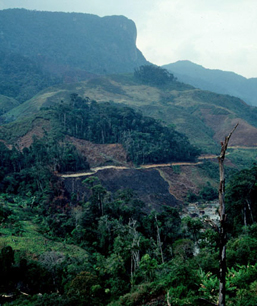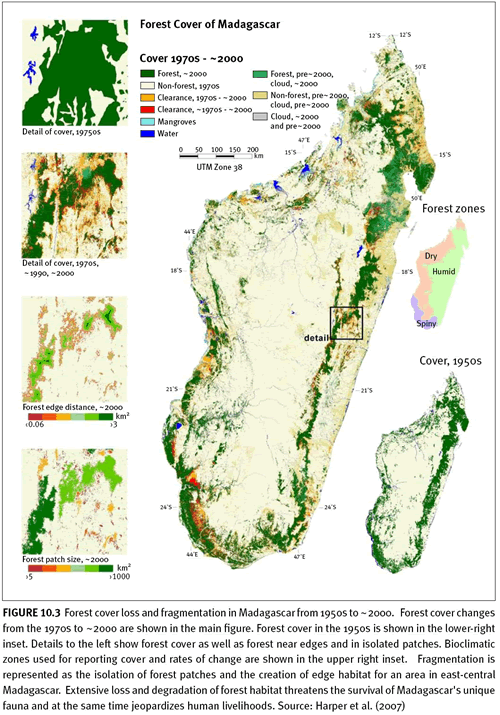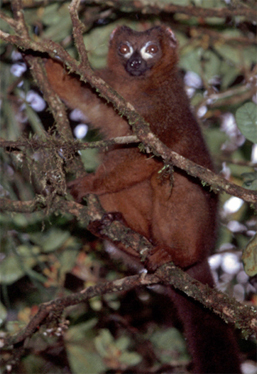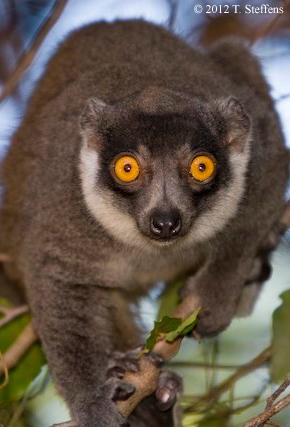What are Edge Effects?

Edges effects are characterized by dynamic,
ecological changes that occur at habitat boundaries; these
include biotic factors--such as changes in species
composition-- and abiotic factors--such as gradients of
moisture, sunlight, soil and air temperature, wind speed, etc.
Hypothetically, if edge effects penetrate 300 m into a 100 ha
square-shaped forest fragment, then approximately only 16% of
the total forest amount will be unaffected by edge effects.
Moreover, fragment shape, orientation, and altitude as well as
matrix conditions can have a major influence on edge
penetration in forest fragments. For example, a long, narrow
forest fragment may be completely dominated by edge effects.
Recent studies indicate that roads, such as the one seen in
the photo to the left and even seemingly undistrubed habitats,
such as riparian forests, create edges. Finally, some species
exhibit only seasonal or successional responses to edges,
which further complicates our understanding of dynamic edge
processes.
Why are Edge Effects Relevant to Forests and Primates in
Madagascar?

Forest habitats are becoming
increasingly fragmented in most tropical regions of the world.
One of the most significant consequences of forest
fragmentation is an increase in the amount of habitat edge.
Edge effects are particularly relevant to the forested regions
of Madagascar, where anthropogenic disturbance over the last
50 years has resulted in the loss of half of the original
forest cover. Forest conversion is due primarily to slash and
burn agriculture and anthropogenic fires used to create cattle
pasture. The remaining forest is highly fragmented and prone
to extreme edge effects, as evidenced by a ground-breaking GIS
study of change in forest loss and fragmentation over a period
of fifty years (Harper et al., 2007). Of the few in situ
studies of edge effects conducted to date, most have
documented how plant and animal abundance covary with edge
proximity in forest fragments. For example, trees in edge
habitats are significantly shorter, have smaller diameters,
and lower stem frequencies than trees in interior habitats in
eastern humid forests. However, there are few data on the
biological processes resulting from edge creation,
particularly in the rare tropical dry forests of Madagascar.
How do Lemurs Respond to Edge Effects?

To date, our research team has focused on
determining edge responses in nine lemur species that range
into eastern humid forests (Vohibola III Classified Forest)
and congenera that are found in western dry forests;
specifically, those in and around
Ankarafantsika National Park, NW Madagascar.
In the humid forests, we found that some lemurs--such as
Eulemur
rubriventer (see photo to left)--exhibit a neutral edge
response (no differences in densities between edge and
interior habitats). Conversely, the smallest-bodied (
Microcebus
rufus) and largest-bodied (
Propithecus edwardsi)
species show a positive edge response (higher densities in
edge habitats), which may be related to edge-related
variations in food abundance.
Cheirogaleus major tends
to exhibit a negative edge response (lower densities in edge
habitats), which we think may be due to spatial patterns of
resource availability and predation pressures. We have now
transitioned all our active fieldwork from Vohibola III to
Ankarafantsika.

Near the Ampijoroa Field Station in
Ankarafantsika, preliminary data indicate that
Propithecus
coquereli rarely exploit edge habitats. We are currently
investigating ecological and anthropogenic correlates to this
distribution pattern. Conversely, two species of mouse lemurs
(
Microcebus murinus and
Microcebus ravelobensis)
differentially exploit forest edges, which contain varying
abundances of important insect resources. Little is known how
the other lemur species, such as
Eulemur fulvus fulvus
and
Eulemur mongoz (such as the handsome individual to
the left), respond to edge effects. Thus, there are ample
opportunities for students to collect basic but critical
information on the distribution and abundance of all lemurs
within the Park.
 Edges effects are characterized by dynamic,
ecological changes that occur at habitat boundaries; these
include biotic factors--such as changes in species
composition-- and abiotic factors--such as gradients of
moisture, sunlight, soil and air temperature, wind speed, etc.
Hypothetically, if edge effects penetrate 300 m into a 100 ha
square-shaped forest fragment, then approximately only 16% of
the total forest amount will be unaffected by edge effects.
Moreover, fragment shape, orientation, and altitude as well as
matrix conditions can have a major influence on edge
penetration in forest fragments. For example, a long, narrow
forest fragment may be completely dominated by edge effects.
Recent studies indicate that roads, such as the one seen in
the photo to the left and even seemingly undistrubed habitats,
such as riparian forests, create edges. Finally, some species
exhibit only seasonal or successional responses to edges,
which further complicates our understanding of dynamic edge
processes.
Edges effects are characterized by dynamic,
ecological changes that occur at habitat boundaries; these
include biotic factors--such as changes in species
composition-- and abiotic factors--such as gradients of
moisture, sunlight, soil and air temperature, wind speed, etc.
Hypothetically, if edge effects penetrate 300 m into a 100 ha
square-shaped forest fragment, then approximately only 16% of
the total forest amount will be unaffected by edge effects.
Moreover, fragment shape, orientation, and altitude as well as
matrix conditions can have a major influence on edge
penetration in forest fragments. For example, a long, narrow
forest fragment may be completely dominated by edge effects.
Recent studies indicate that roads, such as the one seen in
the photo to the left and even seemingly undistrubed habitats,
such as riparian forests, create edges. Finally, some species
exhibit only seasonal or successional responses to edges,
which further complicates our understanding of dynamic edge
processes. Forest habitats are becoming
increasingly fragmented in most tropical regions of the world.
One of the most significant consequences of forest
fragmentation is an increase in the amount of habitat edge.
Edge effects are particularly relevant to the forested regions
of Madagascar, where anthropogenic disturbance over the last
50 years has resulted in the loss of half of the original
forest cover. Forest conversion is due primarily to slash and
burn agriculture and anthropogenic fires used to create cattle
pasture. The remaining forest is highly fragmented and prone
to extreme edge effects, as evidenced by a ground-breaking GIS
study of change in forest loss and fragmentation over a period
of fifty years (Harper et al., 2007). Of the few in situ
studies of edge effects conducted to date, most have
documented how plant and animal abundance covary with edge
proximity in forest fragments. For example, trees in edge
habitats are significantly shorter, have smaller diameters,
and lower stem frequencies than trees in interior habitats in
eastern humid forests. However, there are few data on the
biological processes resulting from edge creation,
particularly in the rare tropical dry forests of Madagascar.
Forest habitats are becoming
increasingly fragmented in most tropical regions of the world.
One of the most significant consequences of forest
fragmentation is an increase in the amount of habitat edge.
Edge effects are particularly relevant to the forested regions
of Madagascar, where anthropogenic disturbance over the last
50 years has resulted in the loss of half of the original
forest cover. Forest conversion is due primarily to slash and
burn agriculture and anthropogenic fires used to create cattle
pasture. The remaining forest is highly fragmented and prone
to extreme edge effects, as evidenced by a ground-breaking GIS
study of change in forest loss and fragmentation over a period
of fifty years (Harper et al., 2007). Of the few in situ
studies of edge effects conducted to date, most have
documented how plant and animal abundance covary with edge
proximity in forest fragments. For example, trees in edge
habitats are significantly shorter, have smaller diameters,
and lower stem frequencies than trees in interior habitats in
eastern humid forests. However, there are few data on the
biological processes resulting from edge creation,
particularly in the rare tropical dry forests of Madagascar. To date, our research team has focused on
determining edge responses in nine lemur species that range
into eastern humid forests (Vohibola III Classified Forest)
and congenera that are found in western dry forests;
specifically, those in and around Ankarafantsika National Park, NW Madagascar.
In the humid forests, we found that some lemurs--such as Eulemur
rubriventer (see photo to left)--exhibit a neutral edge
response (no differences in densities between edge and
interior habitats). Conversely, the smallest-bodied (Microcebus
rufus) and largest-bodied (Propithecus edwardsi)
species show a positive edge response (higher densities in
edge habitats), which may be related to edge-related
variations in food abundance. Cheirogaleus major tends
to exhibit a negative edge response (lower densities in edge
habitats), which we think may be due to spatial patterns of
resource availability and predation pressures. We have now
transitioned all our active fieldwork from Vohibola III to
Ankarafantsika.
To date, our research team has focused on
determining edge responses in nine lemur species that range
into eastern humid forests (Vohibola III Classified Forest)
and congenera that are found in western dry forests;
specifically, those in and around Ankarafantsika National Park, NW Madagascar.
In the humid forests, we found that some lemurs--such as Eulemur
rubriventer (see photo to left)--exhibit a neutral edge
response (no differences in densities between edge and
interior habitats). Conversely, the smallest-bodied (Microcebus
rufus) and largest-bodied (Propithecus edwardsi)
species show a positive edge response (higher densities in
edge habitats), which may be related to edge-related
variations in food abundance. Cheirogaleus major tends
to exhibit a negative edge response (lower densities in edge
habitats), which we think may be due to spatial patterns of
resource availability and predation pressures. We have now
transitioned all our active fieldwork from Vohibola III to
Ankarafantsika. Near the Ampijoroa Field Station in
Ankarafantsika, preliminary data indicate that Propithecus
coquereli rarely exploit edge habitats. We are currently
investigating ecological and anthropogenic correlates to this
distribution pattern. Conversely, two species of mouse lemurs
(Microcebus murinus and Microcebus ravelobensis)
differentially exploit forest edges, which contain varying
abundances of important insect resources. Little is known how
the other lemur species, such as Eulemur fulvus fulvus
and Eulemur mongoz (such as the handsome individual to
the left), respond to edge effects. Thus, there are ample
opportunities for students to collect basic but critical
information on the distribution and abundance of all lemurs
within the Park.
Near the Ampijoroa Field Station in
Ankarafantsika, preliminary data indicate that Propithecus
coquereli rarely exploit edge habitats. We are currently
investigating ecological and anthropogenic correlates to this
distribution pattern. Conversely, two species of mouse lemurs
(Microcebus murinus and Microcebus ravelobensis)
differentially exploit forest edges, which contain varying
abundances of important insect resources. Little is known how
the other lemur species, such as Eulemur fulvus fulvus
and Eulemur mongoz (such as the handsome individual to
the left), respond to edge effects. Thus, there are ample
opportunities for students to collect basic but critical
information on the distribution and abundance of all lemurs
within the Park.